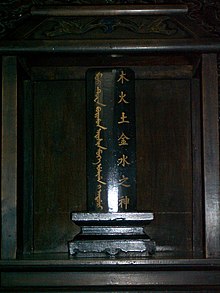
Back Wu Xing Afrikaans نظرية العناصر الخمسة Arabic Wu Xing BCL Cinc processos (Wuxing) Catalan Ngū-hèng CDO Pět prvků Czech De fem faser Danish Fünf-Elemente-Lehre German Ου Σιν Greek Skolo de la kvin elementoj Esperanto

| Wuxing | |||||||||||||||||||||||||||
|---|---|---|---|---|---|---|---|---|---|---|---|---|---|---|---|---|---|---|---|---|---|---|---|---|---|---|---|
| Chinese | 五行 | ||||||||||||||||||||||||||
| |||||||||||||||||||||||||||
| Part of a series on |
| Taoism |
|---|
 |
| Classical elements |
|---|

Wuxing (Chinese: 五行; pinyin: wǔxíng),[a] usually translated as Five Phases or Five Agents,[2] is a fivefold conceptual scheme used in many traditional Chinese fields of study to explain a wide array of phenomena, including cosmic cycles, the interactions between internal organs, the succession of political regimes, and the properties of herbal medicines.
The agents are Fire, Water, Wood, Metal, and Earth.[b] The wuxing system has been in use since it was formulated in the second or first century BCE during the Han dynasty. It appears in many seemingly disparate fields of early Chinese thought, including music, feng shui, alchemy, astrology, martial arts, military strategy, I Ching divination, and traditional medicine, serving as a metaphysics based on cosmic analogy.
- ^ Hayashi, Makoto; Hayek, Matthias (2013). "Editors' Introduction: Onmyodo in Japanese History". Japanese Journal of Religious Studies: 3. doi:10.18874/jjrs.40.1.2013.1-18. ISSN 0304-1042.
- ^ Theobald, Ulrich (2011) "Yin-Yang and Five Agents Theory, Correlative Thinking" in ChinaKnowledge.de - An Encyclopaedia on Chinese History, Literature and Art
- ^ Deng Yu; Zhu Shuanli; Xu Peng; Deng Hai (2000). "五行阴阳的特征与新英译" [Characteristics and a New English Translation of Wu Xing and Yin-Yang]. Chinese Journal of Integrative Medicine. 20 (12): 937. Archived from the original on 2015-07-16.
- ^ Deng Yu et al; Fresh Translator of Zang Xiang Fractal five System,Chinese Journal of Integrative Medicine; 1999
- ^ Deng Yu et al,TCM Fractal Sets 中医分形集,Journal of Mathematical Medicine ,1999,12(3),264-265
Cite error: There are <ref group=lower-alpha> tags or {{efn}} templates on this page, but the references will not show without a {{reflist|group=lower-alpha}} template or {{notelist}} template (see the help page).
© MMXXIII Rich X Search. We shall prevail. All rights reserved. Rich X Search